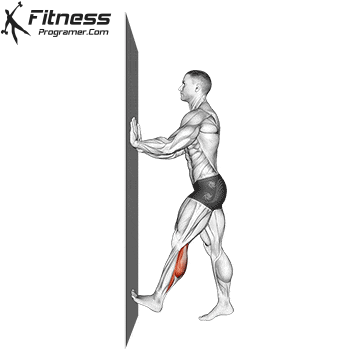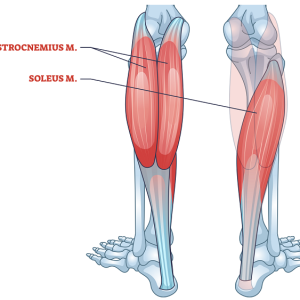Overview
The Standing Wall Calf Stretch is a static flexibility exercise designed to lengthen the gastrocnemius and soleus muscles in the lower leg. By using a wall for support, this stretch helps improve ankle mobility, walking gait, and squat mechanics, while reducing tension caused by running, jumping, or prolonged standing.
It is often included in cool-down routines, mobility sessions, and rehabilitation programs for ankle and foot health.
How to Perform the Standing Wall Calf Stretch

- Setup: Stand facing a wall, about an arm’s length away. Place your hands on the wall at shoulder height.
- Step Back: Move one leg behind you, keeping the toes pointed forward and the heel firmly on the floor.
- Foot Placement: Position one foot slightly forward with the toes against the wall.
- Feel the Stretch: Lean gently into the wall until you feel a stretch along the lower calf and Achilles tendon.
- Hold: Maintain the stretch for 20–30 seconds, breathing deeply.
- Switch Sides: Repeat on the opposite leg. Perform 2–3 rounds per side.
Tips for Proper Form
Keep the heel firmly planted to maximize the stretch.
Avoid letting the knee collapse inward; track it over the toes.
The movement should be slow and controlled—no bouncing.
Adjust the distance to the wall for comfort and intensity.
Maintain an upright posture to avoid lower back strain.
Common Mistakes
Heel lifting off the floor – reduces stretch effectiveness.
Straightening the knee – shifts the stretch to the gastrocnemius instead of the soleus.
Forcing the knee forward – can cause discomfort in the ankle joint.
Twisting the foot – reduces targeted muscle engagement.
Benefits of the Standing Wall Calf Stretch
Increases calf flexibility: Helps lengthen tight gastrocnemius and soleus muscles.
Improves ankle dorsiflexion: Essential for better squat form, running efficiency, and balance.
Relieves Achilles tendon tightness: Helps reduce strain and improve elasticity in the tendon.
Supports injury prevention: Flexible calves and Achilles reduce the risk of strains and overuse injuries.
Enhances athletic performance: Improves lower leg function for running, jumping, and agility drills.
No equipment required: Simple and effective stretch that can be done anywhere with a wall.
Muscles Worked

Frequently Asked Questions
Should I keep my back knee straight or bent?
Straight targets the gastrocnemius; bent emphasizes the soleus.
How often should I do this stretch?
Daily stretching is safe and effective, especially for athletes or those with calf tightness.
Can I use this before workouts?
Yes, but keep holds shorter (10–15 seconds) before activity; longer holds are best post-workout.
Should I feel this in the upper calf?
Not primarily—most of the stretch should be felt lower in the calf and near the Achilles.
Is this good for plantar fasciitis?
It can help indirectly by reducing tension through the calf-Achilles-plantar fascia chain.
